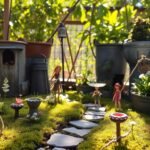For centuries, people across Europe crafted tiny landscapes to celebrate nature’s mysteries. Today, these whimsical creations let you blend artistry with sustainability. Whether adorning a windowsill or transforming backyard corners, miniature scenes invite wonder through everyday materials.
What makes these projects special? They adapt to any container – from teacups to weathered planters. Children learn responsibility nurturing small plants, while adults enjoy mindful creativity. Best of all, you’ll give discarded items new life as bridges, fairy houses, or sparkling pathways.
Your journey begins by reimagining objects around you. That chipped mug becomes a mossy cottage. Fallen twigs turn into rustic fences. For inspiration, explore our guide to DIY garden art that personalizes outdoor spaces through upcycled treasures.
There’s no right or wrong way to design your tiny realm. Let pebbles become stepping stones and bottle caps transform into miniature ponds. Each creation reflects your unique story while connecting you to centuries-old traditions of nature-inspired storytelling.
Understanding the Magic: What is a DIY Fairy Garden?
Long before modern science, mysterious happenings in nature were often attributed to unseen magical beings. These stories birthed traditions where tiny worlds became portals to imagination—a practice now reborn through sustainable crafting.
History, Folklore, and Cultural Inspirations
For centuries, European communities saw fairies as forces shaping weather, health, and crop growth. As Fifth Season Gardening notes:
“Fairy folklore explained the unexplainable—sudden storms, healing herbs, or twisted tree roots.”
These beliefs wove through daily life, turning ordinary landscapes into realms of wonder. Today, that legacy lives when you shape mossy cottages from cracked bowls or fashion twigs into mystical arches.
Modern Eco-Friendly Adaptations
Your creations now blend ancient charm with earth-conscious choices. Repurposed jar lids become shimmering ponds, while bottle caps form walkways. This approach honors tradition while reducing waste—magic meets mindfulness.
Families bond while teaching kids about nature’s cycles. Grandparents share folklore as little hands arrange pebble paths. Together, you craft more than decorations—you nurture creativity and environmental care in one enchanting world.
Gathering Your Materials: Recycled and Natural Options
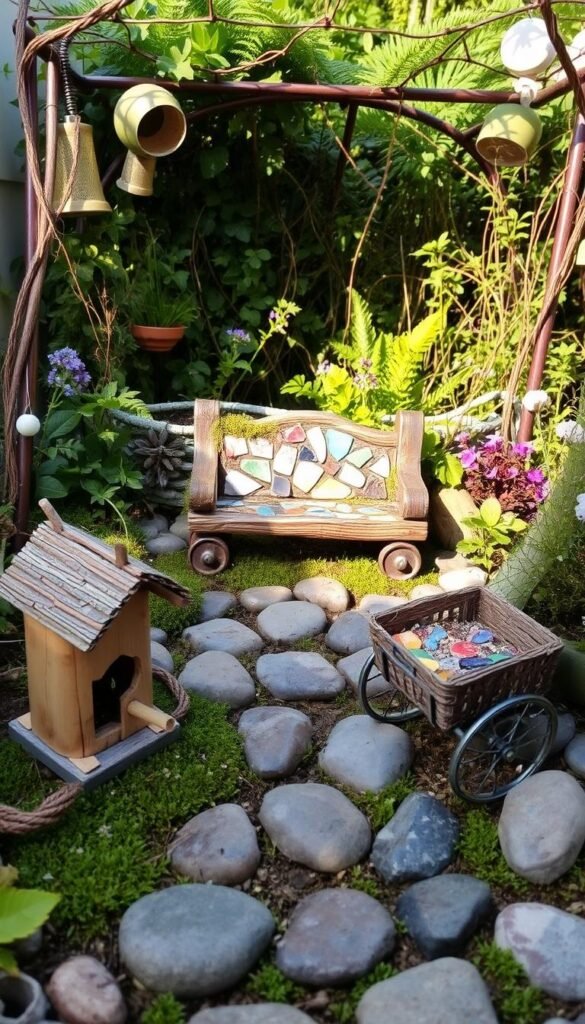
Your journey into miniature magic starts with a scavenger hunt in your own home. Look at everyday objects with fresh eyes—that cracked planter becomes a hillside cottage, while a colander transforms into a hanging garden. The best materials often hide in plain sight.
Sourcing Recycled Materials and Eco-Friendly Supplies
Begin by raiding your recycling bin. Cleaned plastic bottles make excellent water features when cut creatively. Old lunchboxes and tea tins become weatherproof containers perfect for outdoor displays. Even broken clocks can become circular pathways with some moss and glue.
Nature provides free treasures. Collect smooth stones during family walks for stepping stones. Dry twigs form rustic fences, while acorn caps become tiny bowls. Local parks often allow small natural materials collection—just avoid protected areas.
For budget-friendly sparkle, visit your nearest dollar store. Mini mirrors create instant ponds, while plastic gems add magical accents. Pair these finds with crafts supplies like popsicle sticks—turn them into benches using wood glue and patience.
Remember: mixing repurposed items with natural materials gives your creation depth. That chipped mug holds more potential than any store-bought planter. As you arrange your finds, you’ll discover sustainability makes the magic more meaningful.
Step-by-Step DIY Fairy Garden Ideas using Recycled Materials
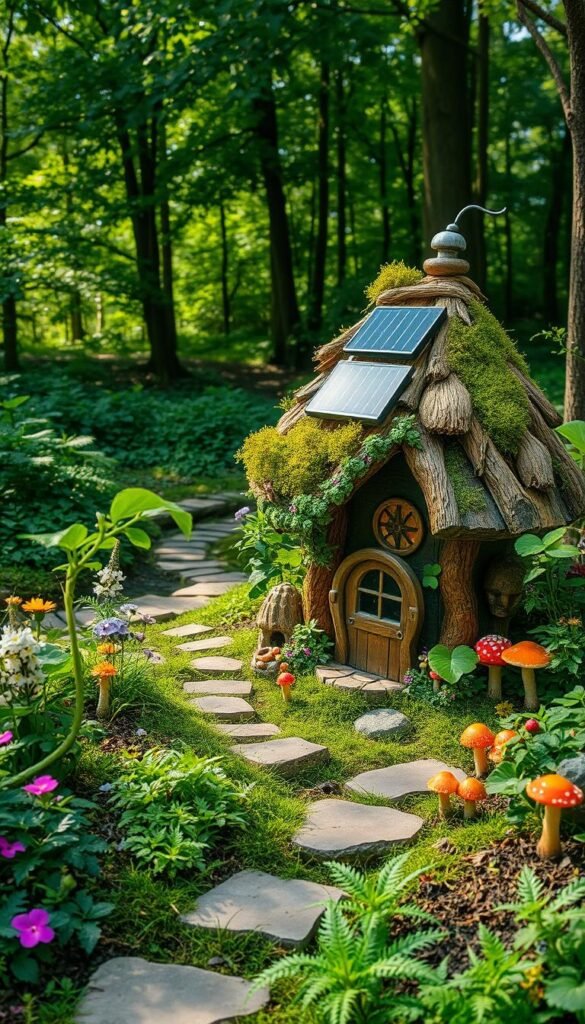
Transforming everyday items into magical dwellings starts with clever preparation. Your plastic bottle becomes the foundation – wash it thoroughly and measure twice before cutting. Safety first: use sharp scissors to remove the top third, creating a stable base for your fairy house.
Preparing Your Recycled Containers and Natural Bases
Choose containers with character – a warped soup bowl or faded lunchbox adds instant charm. For the solar light roof method, ensure your bottle opening is 1-2 inches smaller than the light’s diameter. This creates a snug fit that withstands weather while allowing easy access for bulb changes.
Detailed Build Process for Your Fairy Garden
Spread decoden clay like frosting on a cake, working quickly before it sets. Position your fairy door slightly off-center for visual interest. Press stones into the clay around entryways, using flat ones near windows for stability. Imperfections? They add rustic appeal!
Let your creation cure in a dry area – rushing this step risks crumbling. In humid climates, place near a fan for faster drying. Once hardened, twist the solar light into place as a glowing crown. For plant-filled versions, line Chick-fil-A containers with landscape fabric before adding soil and moss.
Remember: mix textures for depth. Glue sand around the base for a beach theme or birch bark scraps for woodland vibes. Your tutorial-worthy masterpiece proves sustainability sparks the best magic.
Creative Design Ideas and Inspirations for Your Enchanting Space
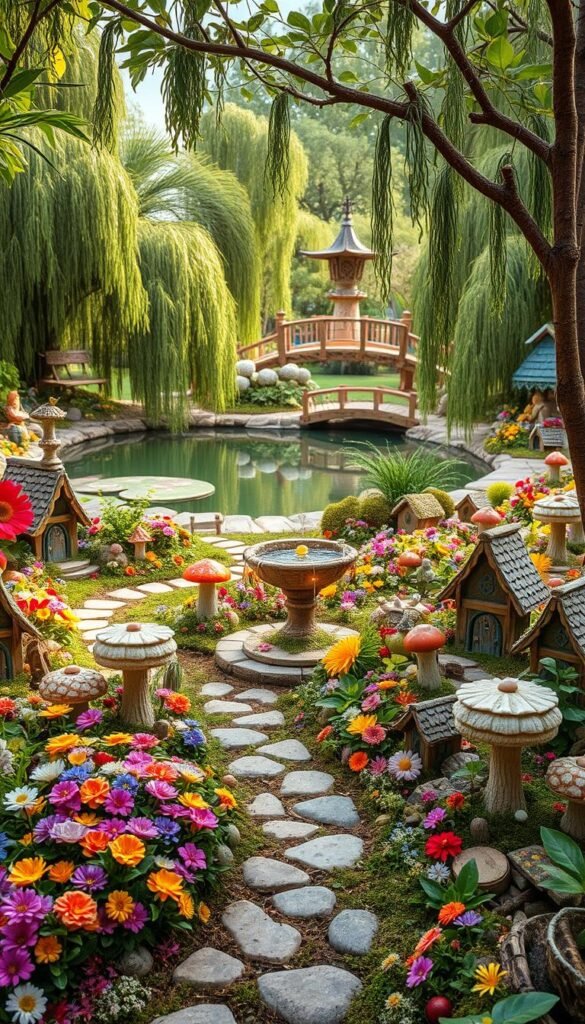
Your miniature wonderland becomes a storytelling canvas through thoughtful design choices. Themes act as blueprints, guiding material selection and accessory placement while sparking imaginative narratives.
Selecting Themes: Coastal, Woodland, or Modern Concepts
Coastal scenes thrive with bleached shells as pathways and tiny driftwood benches. Add a miniature lighthouse from craft stores, surrounded by blue glass shards mimicking ocean waves. For woodland realms, arrange bark strips as climbing walls and acorn caps as fairy hats.
Urban concepts shine with repurposed hardware – nuts become bistro tables, washers transform into mirrors. Seasonal twists keep displays fresh: pumpkin-shaped houses in autumn or icicle ornaments during winter.
Illuminating Details: Lighting and Decorative Accents
Twinkle lights wrapped around twig arches create celestial ceilings. Bury solar-powered LEDs under translucent pebbles for glowing walkways. Miniature street lamps from model train sets add urban charm while providing ambient light.
Combine natural elements with crafted touches. Moss carpets pair beautifully with clay mushroom clusters. Driftwood bridges complement seashell fountains, blending textures for visual depth.
Balancing Handmade Charm and Curated Finds
Paint pebbles as storybook houses, then pair with store-bought garden accessories like metal butterflies. Craft benches from popsicle sticks, but splurge on a detailed weathervane. This mix maintains personality while achieving polished results.
Remember: your creation evolves. Swap seashells for pinecones when seasons change. Add holiday-themed flags or miniature wreaths. Each adjustment keeps the magic alive while showcasing your growing craft skills.
Troubleshooting & Pro Tips for a Lasting Fairy Garden
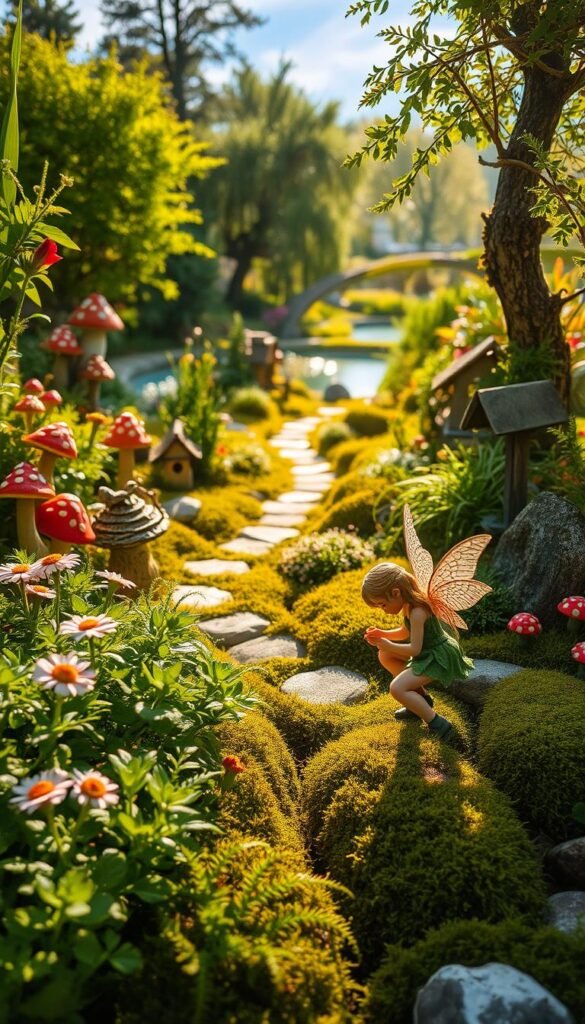
Even the most magical creations need practical care to thrive. Let’s explore solutions for common challenges and smart strategies to keep your miniature world vibrant through seasons.
Avoiding Common Pitfalls in DIY Construction
Solar light sizing matters more than you think. Measure your container’s opening before choosing lights—too small, and they’ll wobble; too large, they’ll crack clay during installation. Test decoden clay dryness by pressing a toothpick into hidden spots. If it leaves marks, wait another 24 hours.
Outdoor setups demand weatherproofing. Seal wooden accessories with beeswax instead of varnish—it repels water without harming plants. For drainage issues, drill small holes in container bottoms and layer pebbles beneath soil. This prevents root rot during rainy months.
Maintenance, Seasonal Adjustments, and Upcycling Ideas
Refresh your display every 3 months. Trim moss with nail scissors and swap faded fabrics for colorful bottle-cap flags. In winter, wrap delicate houses in burlap or move them indoors. Summer heat? Add shade with a repurposed coffee filter parasol.
Upcycle household items for new features:
- Old keys become rustic signposts
- Broken necklace chains form shimmering rivers
- Plastic berry baskets make perfect trellises
Rotate accessories with holidays—tiny pumpkins in fall, seashells in summer. These small changes keep the magic alive while letting your fairy house evolve naturally. Remember: imperfections add character, so embrace weathered textures and uneven pathways.
Bringing Your Fairy Garden to Life: Final Touches and Display Ideas

Your enchanted creation comes alive through thoughtful finishing touches. A sprinkle of glitter on pathways catches sunlight by day and moonlight after dark, while tiny quartz crystals add natural sparkle. Position your miniature world where morning light charges solar elements, ensuring your fairy house glows softly through evening hours.
Display arrangements transform ordinary spaces into magical vignettes. Cluster smaller gardens on a windowsill for a twinkling village effect, or make one the centerpiece of your outdoor dining table. For functional charm, nestle battery-operated tea lights among mossy rocks to create safe, flickering night lights.
These final details do more than beautify—they invite wonder. Children will peer into miniature doorways imagining secret stories, while adults appreciate how repurposed materials gain new purpose. Whether brightening a desktop or illuminating a porch, your garden becomes a testament to creativity’s power to transform the everyday into extraordinary.

